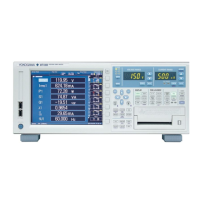2-21
IM WT1801-01EN
Averaging Types (Type)
You can use exponential or moving averages.
Exponential Averaging (Exp)
With the specified attenuation constant, the numeric data is exponentially averaged according to the equation
below.
D
n
: Displayed value that has been exponentially averaged n times. (The first displayed value, D
1
, is equal to M
1
.)
D
n–1
: Displayed value that has been exponentially averaged n – 1 times.
M
n
: Measured data at the n
th
time.
K: Attenuation constant (select from 2 to 64)
Moving Average (Lin)
The specified average count is used to compute moving averages according to the equation below.
Dn =
Mn
−
(m
−
1)+ • • • Mn
−
2+Mn
−
1+Mn
m
D
n
: n–(m–1)
th
to the n
th
time
M
n–(m–1)
: Measured data at the n–(m–1)
th
time
………………………………………………
………………………………………………
M
n–2
: Measured data at the n – 2
th
time.
M
n–1
: Measured data at the n – 1
st
time.
M
n
: Measured data at the n
th
time.
m: Average count (select a number from 8 to 64)
Attenuation Constant or Average Count (Count)
• If the averaging type is Exp (exponential averaging), set the attenuation constant to a value within the
following range.
2 to 64
• If the averaging type is Lin (moving average), set the average
count to a value within the following range.
8 to 64
Measurement Functions That Are Averaged
The measurement functions that are directly averaged are indicated below. Other functions that use these
functions in their computation are also affected by averaging. For details about how the values of the
measurement functions are determined, see appendix 1 in the getting started guide, IM WT1801-03EN.
Measurement Functions Used in Normal Measurement
• Urms, Umn, Udc, Urmn, Uac, Irms, Imn, Idc, Irmn, Iac, P
, S, and Q
• ΔU1 to ΔPΣ (on models with the delta computation option)
• Torque, speed, and Pm (on models with the motor evaluation option)
• Aux1 and Aux2 (on models with the auxiliary input option)
• λ, Φ, CfU, CfI, Pc, q, q+, q–, and η1 to η4 are computed using the averaged values of Urms, Irms, P, S, and Q.
• Slip is computed using the averaged value of Speed (on models with the motor evaluation option).
Measurement Functions Used in Harmonic Measurement (Option)
• U(k), I(k), P(k), S(k), and Q(k)
•
λ(k), and Φ(k) are computed using the averaged values of P(k) and Q(k).
• Z, Rs, Xs, Rp, Xp, Uhdf, Ihdf, Phdf, Uthd, Ithd, Pthd, Uthf, Ithf, Utif, Itif, hvf, hcf, and K–factor are computed
using the averaged values of U(k), I(k), and P(k).
k: The harmonic order
2 Fundamental Measurement Conditions

